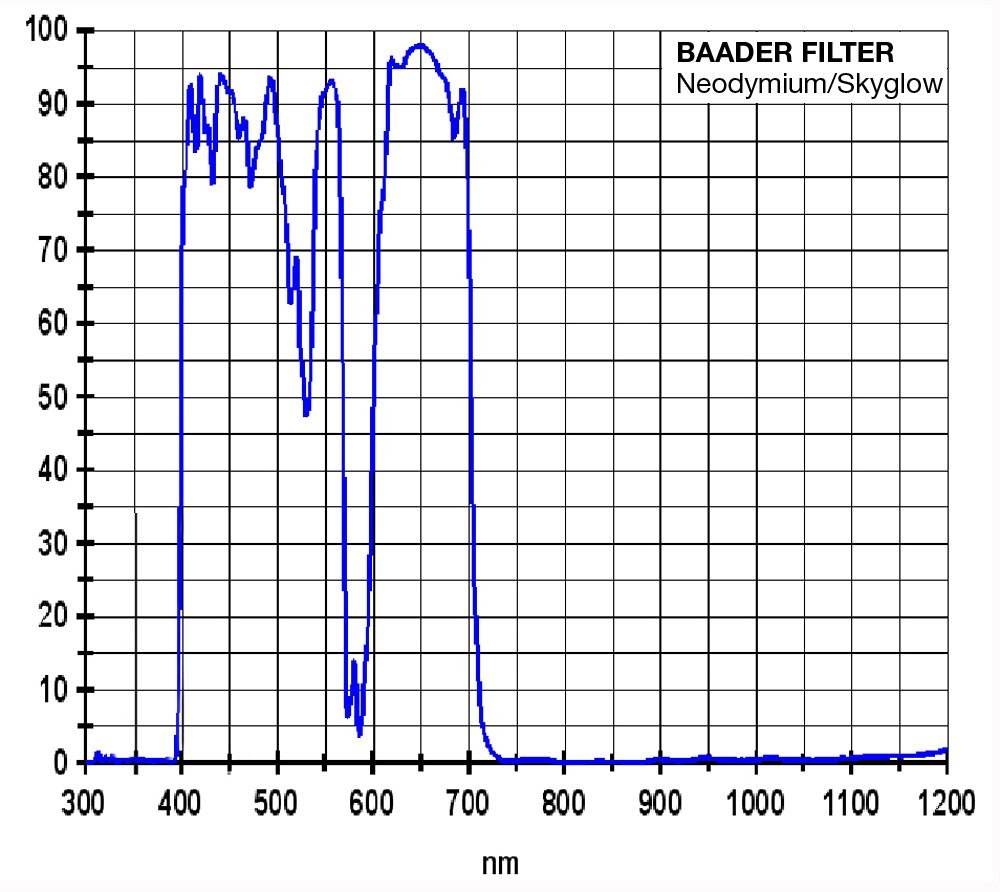Baader Neodymium 2" (Moon & Skyglow)-Filter
- The best visual and photographic filter for contrast enhancement for all telescopes, without loss of image brightness!
- The effect of the element neodymium as filter material is very impressive. When added to optical glass, it enhances contrast, enhances the red colour in the image (especially with Mars and Jupiter) and it darkens the spectral region which is particularly marked by street lamp light, which is the biggest contributor to the nightly "Skyglow".
- Planoptically polished and MC-coated – with IR-cut coatings!, without any loss of sharpness as a single filter in front of a binocular or be used for afocal projection with digital cameras (far from the focal point!)
- The IR spectral range is blocked making stars much sharper when used with dSLRs.
With integrated IR blocker and Phantom Group Coating
Drastic contrast enhancement for all telescopes, without loss of image brightness! This filter is initially based on a development by Carl Zeiss. The effect of the element neodymium as filter material is very impressive. If used as co-mixture to optical glass, it improves the contrast and enhances the red portions of the image (especially for Mars and Jupiter). At night it blocks that part of the spectrum, which suffers most from street lighting – and it blocks the light pollution, also known as „skyglow“. And lastly, the applied UV/IR blocking coating (Luminance-coating - check the spectral trace) cuts all unwanted UV below 400 nm and NIR above 700 nm - this makes it the „sharpest contrast enhancing filter“ for imaging.
Compare with the moon & Skyglow filter before the naked eye, to test the effectiveness. Red and blue colours are extensively strengthened. If you cannot see the GRS (Great Red Spot) due to pollution try this which will allow you to see it.
In order to establish a precise plan area and to maintain the planarity despite the applied forces through the different layers of coating, a high technical effort is necessary. You have to choose from a large amount of raw glass only the best pieces in tension-free annealed quality to even hope for a good final quality may. All too easily, the glass deforms with improper preparation or coating on older evaporation systems. The final product is almost useless, if not greatest of care is taken at every stage of production.
SURFACE DETAILS ON MARS, JUPITER AND MOON AS WELL AS MANY DEEP-SKY-OBJECTS BECOME MUCH MORE PROMINENT.
- Selective contrast filter, especially suitable for all reflector telescopes
- Filters out specific wavelengths, especially those caused by streetlight and most importantly their scattered light which lightens up the night sky
- Selective blocking retains natural colours intact but with RGB significantly enhanced, differences in colour and brightness persist.
- 95% transmission in the selected spectral range.
- Fits all standard filter threads and can be combined with other filters – e.g. the planeoptically
polished (!) Baader planetary colour filters. This way, you can see fine details better or combine several images with a monochrome camera to achieve colour images. - The filter is at the same time optimised for Astrophotography due to it‘s full UV/IR-blocking coating. When used with DSLRs, stars will remain much tighter, because the unfocussed UV and IR parts of the spectrum are blocked out.
- Planeoptically polished; can be used without problems in front of a binoviewer or for afocal photography – far away from the focus without loosing sharpness!
- The fine-optical polish and absence of wedge error in the glass ensure perfect sharpness when magnifying more than 200x - while the much cheaper “fire -polished” filter glasses destroy the optical wavefront at high mags
- Neodymium doped optical glass
- Coatings Front/Back: 7-layer hard-BBAR-coating / 27-layered dielectrical UV/IR-cut coating
- Ultra-hard and durable Ion-beam hardened coatings – may be cleaned anytime without fear
Spectral Curve of the Moon & Skyglow Filter

The adjacent graph shows you the spectral curve of our Neodymium Moon & Skyglow filters. On the horizontal axis, the wavelength in nanometers, and the vertical axis is the transmission amount (opacity) specified in percent.
The area under the curve is the spectral range that can pass through the filter.
Important note: Before you buy a "Moon and Skyglow" filter, which is now available from several manufacturers, compare the transmission curves! You will find that the original "Baader Moon&Skyglow" filter has the highest transmission and is blocked in the UV/IR, with the same layer system as a Baader L filter. This means sharper images because only the spectral range where the telescope can deliver a sharp image, reaches the chip. In addition, our filter is plano-optically polished. Only few manufacturers are willing to do this, only because of this the filter is also suitable for the highest magnifications.
| TRANSMISSION RANGE | multiple bands (see spectral image) |
|---|---|
| FILTER THICKNESS (WITHOUT CELL) | 1 mm |
| AR-COATING | Phantom Coating® Group, planeoptically polished |
| FILTER USAGE | CCD, Contrast Enhancement, Color Correction, IR-Cut, Light Pollution Reduction, Lunar, Planetary |
| TYPE OF FILTER | Bandpass |
| SINGLE OR SET? | Single Filter |


